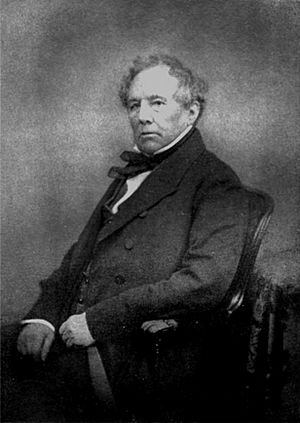John Dickinson (inventor) facts for kids
John Dickinson (born March 29, 1782 – died January 11, 1869) was a brilliant inventor from England. He created a new way to make paper using machines, which was a big step forward. In 1809, he started a company called Longman & Dickinson. This company later grew into John Dickinson Stationery Limited, a very well-known paper and stationery producer.
Contents
Early Life
John Dickinson was the oldest son of Captain Thomas Dickinson, who worked for the Royal Navy. His mother, Frances, came from a family of French silk weavers.
When John was just fifteen, he began learning the stationery business. He spent seven years as an apprentice with a company in London. An apprentice is someone who learns a skill or trade by working for an expert. In 1804, he officially joined a special group for paper sellers called the Stationers' Company. After that, he started his own business selling stationery in London.
A Clever Inventor
John Dickinson was very creative and good at solving problems. He invented a special kind of paper for cannon cartridges. Before his invention, the paper used in cannons would sometimes keep burning after the cannon fired. This could cause dangerous accidental explosions.
Dickinson's new paper did not smoulder, making cannons much safer. He got a patent for his invention, which meant he legally owned the idea. The army quickly started using his paper. It was very helpful during battles against Napoleon, allowing British soldiers to fire their cannons faster and with fewer accidents.
Building Paper Mills
Before John Dickinson, most paper was made by hand. People had tried to build machines to make paper continuously, but it was difficult. One famous attempt was by a Frenchman named Henry Fourdrinier.
In 1809, John Dickinson patented his own design for a paper-making machine. That same year, he teamed up with George Longman, whose family owned the famous Longman publishing company. Together, they formed a new company called Longman & Dickinson.
With financial help, Dickinson bought an old flour mill in Apsley, England. The previous owner had already started making paper there. Dickinson installed his new machines in the mill. In 1811, he bought a second paper mill nearby in Nash Mill. Between 1828 and 1830, he built a third mill in Croxley. The canals near these mills were very important. They provided power for the machines and helped transport materials and finished paper.
Dickinson also invented special paper with silk threads inside for security. This was used for things like money or important documents. He also developed envelopes with a sticky gum to seal them, which started being produced in 1850.
In 1836, John Dickinson designed and built his own house. He called it Abbots Hill. It was built on a hillside, looking down at his busy paper mills in the valley below.
In 1858, John Dickinson handed over his successful business to his nephew, John Evans. Over the years, the company grew and merged with other stationery makers. Today, John Dickinson Stationery is one of the biggest stationery companies in the world.
How Dickinson Made Paper
John Dickinson's paper-making process was very clever. It used a large metal cylinder with tiny holes and a fine wire mesh cover. This cylinder spun around in a big vat filled with wood pulp (a watery mix of wood fibers).
As the cylinder turned, the water from the pulp was pulled away through the center of the cylinder. This left the wood fibers clinging to the wire mesh on the cylinder's surface. A long, moving belt of felt then pressed against the cylinder. This belt picked up the layer of wet pulp. Once this layer dried, it became a continuous sheet of paper!
John Dickinson's Family
John Dickinson was likely born in London. He was the oldest of nine children. In 1810, he married Ann Grover. Her father was a senior partner in a bank in Hemel Hempstead. John and Ann had seven children.
His nephew and son-in-law, John Evans, took over the family business. John Evans also became famous in several areas of study, not just business.
John Dickinson's grandchildren included Sir Arthur John Evans, who was a curator at the Ashmolean Museum and famous for digging up ancient ruins in Crete. Another grandchild was Lewis Evans, who was a well-known collector.
According to his family, the Dickinsons were distantly related to another famous person named John Dickinson (1732-1808). This American John Dickinson was one of the Founding Fathers of the United States.


